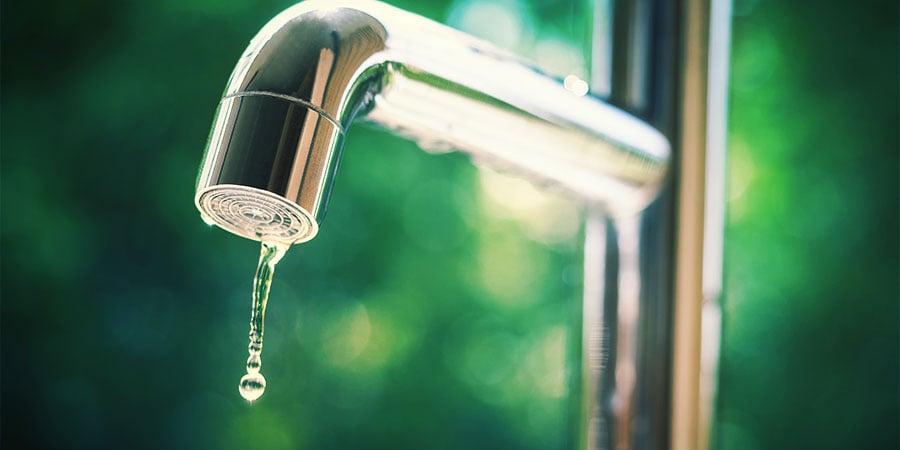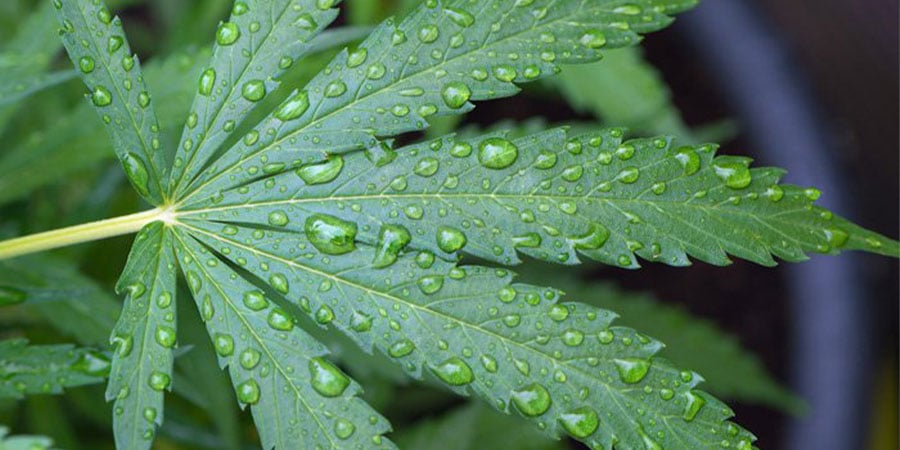What Is The Best Water For Cannabis Plants?
Nothing can be more important for successful cannabis growing than water quality and the proper watering technique. Learn about the best water for your cannabis plants!
You can spend all the time in the world growing cannabis and invest a lot of money in your grow room, nutrients, and additives. Yet, if your water is not optimal or you make mistakes with watering, it may lead to problems that you can learn to avoid.
Water quality is everything when you grow cannabis. Water is what helps transport the required nutrients and oxygen through your plants. When something is off with the quality of your water, plants cannot get what they need to grow and problems are around the corner.
THE IMPORTANCE OF YOUR WATER’S PH
The pH value is what specifies the acidity or basicity (alkalinity) of fluids. Acidic water has a low pH and the pH of water that is alkaline is higher. A pH of 7 means that water is neutral. Any water can be either more alkaline or more acidic, depending on the water’s source and other factors.
When we look at the pH scale that ranges from 0 (extremely acidic) to 14 (very alkaline), we find that cannabis has a very small pH range where it can grow well. This range is roughly between pH 6 and pH 7, with pH 6.5 being the optimal middle.
This is where cannabis is able to take up many nutrients such as nitrogen, phosphorus, calcium and others. If the water’s pH range is just off a slight amount, the plant cannot take up certain nutrients even if they are present. The plant develops deficiencies. This “nutrient lockout” is often related to water problems and not so much to the nutrients you feed.
For example, when the water’s pH is too high (alkaline), your plants cannot take-up iron while a low pH will cause problems because your plants cannot get sufficient calcium or magnesium. You will now understand why the right pH of your water is so important for the proper growth of your plants.
HOW TO ADJUST YOUR WATER’S PH?
Since it is not so likely that your water will have the correct pH right away, you have to know how to either increase or decrease its pH so it is in the optimal range of about pH 6.5 (for soil) or even lower for hydroponic growing.
Every cannabis grower should have a “pH down” or “pH up” product for this purpose. Any decent grow shop will carry those. “pH down” is usually a strong acid where you add a tiny amount to your water to increase its acidity and lower its pH value. Most of the time you will be fine with just “pH down” since it is more likely you will have to decrease the pH rather than increase it. Before you water, you would “pH” your water into the right pH range, say to a pH of 6.5ish.
NUTRIENTS, ORGANIC GROWING AND YOUR WATER’S PH
There are some exceptions where you would not need to adjust your water’s pH. Many commercial cannabis nutrients are already decreasing the pH of water. Those products are often made with the fact in mind that most people’s tap water has a high pH. For example, your water right from the tap may have a high pH of 8.5.
If you use the recommended amount of your nutrient, it decreases its pH to 6.5 so you would not have to add any additional “pH down”. On the other hand, not all commercial nutrients provide this benefit. Some nutrients may not alter your water’s pH a lot. You will still need to measure and adjust your water’s pH. Important: You do this after you added nutrients or other additives to your water. If you find that the water is out of the optimal pH range of 6-7, you need to adjust the pH.
If you grow organically in soil, your water’s pH value is not that important. With organic growing, living beneficial microorganisms help the plants to take up nutrients. Some recommend not to adjust your water’s pH at all when you grow organically in soil, it may in fact do more harm than it is beneficial.
IS TAP WATER SUITABLE FOR CANNABIS?
As mentioned above, the water’s pH and overall quality can vary. Most tap water has a high pH so it’s not optimal for cannabis growing. You can find out your water’s exact pH value by measuring the acidity with a pH stick or use a pH test kit. Your water provider should also have reports available where they publish test results about your water’s quality including its pH.
IS CHLORINE IN TAP WATER A PROBLEM?
However, your water’s pH value, its acidity or alkalinity is not all that you need to be watchful for. Water from the tap is normally containing chlorine that is added to the water to prevent growth of bacteria and harmful microorganisms.
For organic cannabis growing, chlorine is a problem. Organic growing depends on thriving, beneficial microorganisms. Chlorine in the tap water doesn’t differentiate between good and bad bacteria. If you were to water your organically grown plants right from the tap, you would kill the beneficial microorganisms.
On the other hand, if you don’t grow organically and this includes most hydroponic systems, the chlorine found in tap water is less a problem. Just know that some additives or biological pesticides can be living microorganisms that won’t take well to chlorine in fresh tap water.
GETTING RID OF CHLORINE IN TAP WATER
While chlorine doesn’t cause a problem for most hydroponic or non-organic grows, growers are often wanting to dechlorinate their water before use. This is actually pretty easy to do. All you need to do is fill a bucket with tap water and let it sit for about 24 hours. Most of the chlorine will by then have evaporated and the water is safe to use.
WHAT IS THE PROPER WAY TO WATER CANNABIS?
As we mentioned, your water quality and watering plants properly are essential for healthy growth. Fact is that most cannabis problems are actually stemming from mistakes with watering. Especially new growers may run into problems that come from either overwatering or underwatering.
Overwatering may clog and choke the plant’s roots so that oxygen cannot reach them. This becomes a problem if the inexperienced grower notices a problem with his/her plants but incorrectly thinks this has to do with the nutrients they feed. Rather than addressing the actual problem (too much watering), the grower may increase the amount of nutrients instead.
The grower may continue overwatering or even assume that the problem is from not enough water and make the problem only worse by watering even more. Most growing problems CAN be solved if just the watering would be done right!
“It is better to underwater than to overwater”
There is a simple saying among growers that goes like “It is better to underwater than to overwater”. It is beneficial for your plants when the soil can dry out between watering. This helps bringing oxygen to the plant’s roots. Some growers even water only when they see the first signs of underwatering, that is, when the plants start to wilt slightly. This is not a problem at all, they will recover quickly.
Allow the soil in your pot to dry out before each new watering. A common test whether your soil is dry can be if you stick your finger in the soil and find the first 2-3 inches down dry. Another simple and even better test can be when you lift and weigh the pot. Water only when the pot is very light, which means when the soil is dry.
HOW MUCH WATER TO GIVE TO YOUR PLANTS?
You should not water “on a schedule”. Overwatering doesn’t mean giving “too much” water at once but watering too frequently, without giving the soil a chance to dry. Instead of watering frequently, you should water when the plants need it.
However, when you water, make sure that you water well. Water so that the entire soil in the pot is well drenched. A good rule is to water until some of the water that you give comes out from the holes at the bottom of the pot. (It is important that the plants have adequate drainage. Pots should always have holes at the bottom so that water doesn’t sit in the pot.)
Some potting mixes and mediums such as peat can require some time to soak up the water, especially when they are dry. It is good practice when you start watering your plants, then wait 30 minutes and continue watering to make sure that the soil takes in all the water. Otherwise it could happen that most of the water simply flows down at the sides and out without having drenched the soil.
As we showed you, what is the best water for your cannabis plants can depend on various factors. The way in which you grow (organically, in soil, hydroponically etc.) plays a role as does the quality of the water available to you.
In almost all cases, you can improve your water’s quality to make it optimal for your plants and growing technique. Always be aware about the importance that water and the correct watering technique have to make a grow a success. Most cannabis problems such as nutrient deficiencies are related to water. Water properly and use the right water and your plants will thrive!
-
 6 min
1 April 2021
How To Make The Best Soil Mix For Growing Cannabis
Cannabis plants depend on soil rich in nutrients and beneficial microbes. Discover how to make the perfect soil mix below. Your plants will thank you!
6 min
1 April 2021
How To Make The Best Soil Mix For Growing Cannabis
Cannabis plants depend on soil rich in nutrients and beneficial microbes. Discover how to make the perfect soil mix below. Your plants will thank you!
-
 3 min
31 July 2019
How To Adjust pH Level When Growing Cannabis
In this article, we’ll teach you all you need to know about the importance of pH when growing cannabis, and how to change your pH levels if necessary.
3 min
31 July 2019
How To Adjust pH Level When Growing Cannabis
In this article, we’ll teach you all you need to know about the importance of pH when growing cannabis, and how to change your pH levels if necessary.
-
 4 min
20 February 2019
Molasses And Cannabis: Taking Your Soil To The Next Level
Molasses is a powerful, yet often overlooked tool when it comes to growing cannabis. Properly used, it can strengthen and boost the very foundation of your grow.
4 min
20 February 2019
Molasses And Cannabis: Taking Your Soil To The Next Level
Molasses is a powerful, yet often overlooked tool when it comes to growing cannabis. Properly used, it can strengthen and boost the very foundation of your grow.
-
 4 min
14 August 2018
How Much Water Do Cannabis Plants Need?
Just as with humans, cannabis plants need water to survive and thrive. But too much - or too little - and they die. Finding the right balance is crucial for an abundant harvest.
4 min
14 August 2018
How Much Water Do Cannabis Plants Need?
Just as with humans, cannabis plants need water to survive and thrive. But too much - or too little - and they die. Finding the right balance is crucial for an abundant harvest.













 United States
United States














